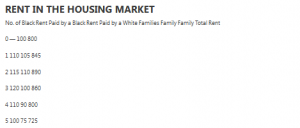RENT IN THE HOUSING MARKET

No. of Black Rent Paid by a Black Rent Paid by a White Families Family Family Total Rent
0 — 100 800
1 110 105 845
2 115 110 890
3 120 100 860
4 110 90 800
5 100 75 725
6 90 75 690
7 85 70 665
8 80 — 640
The column entitled “Total rent” is the sum of the monthly rents collected by the landlords of the eight homes. For example, if there are three black fam- ilies, then each black family pays $120/month and each of the five white fam- ilies pays $100/month, for a total collected monthly rent of $860. Note that the landlords’ rent is maximized at $890, when two of the homes are rented to black families.
The game of interest is not between black and white families, but rather be- tween the landlords who own the eight homes. Suppose that each home is
owned by a different person and the payoff of a landlord equals the rent col- lected. Then, in deciding to whom to rent their property, will the landlords se- lect strategies that result in a racially integrated neighborhood? Or will their decisions cause the neighborhood to “tip” from being all white to all black?
The concept of strict dominance allows us to say what will happen. Consider the decision faced by an individual landlord, and suppose the other seven landlords are currently renting to only white families. Then the first landlord will earn $10 more a month ($110 versus $100) by renting to a black family. Hence, he will prefer to rent to a black family when the other seven homes are rented to white families. Now suppose instead that, of the other seven homes, six are rented to white families and one to a black family. Then if the landlord in question rents to a black family, he’ll earn $115 (since there are now two black families in the neighborhood), an amount of money that exceeds what he can earn by renting to a white family, which is only $105 (when there is only one black family). It is thus to the landlord’s advantage to rent to a black family when six of the other seven houses are rented to white families. Continuing in this manner, you can show that, regardless of what the other seven landlords are doing (in terms of the race of their tenants), an in- dividual landlord makes more money by renting to a black family. In other words, renting to a black family strictly dominates renting to a white family.
The monetary benefit applies to each of the landlords, so if each uses his or her dominant strategy, then each will rent to a black family. As a result, the neighborhood shifts from being all white to all black. Notice, however, that if all the houses are rented to black families, then the landlords end up with a lower total rent of $640, compared with the $800 they got when they were all renting to white families. Sadly, then, landlords are poorer and racial integra- tion is not achieved.